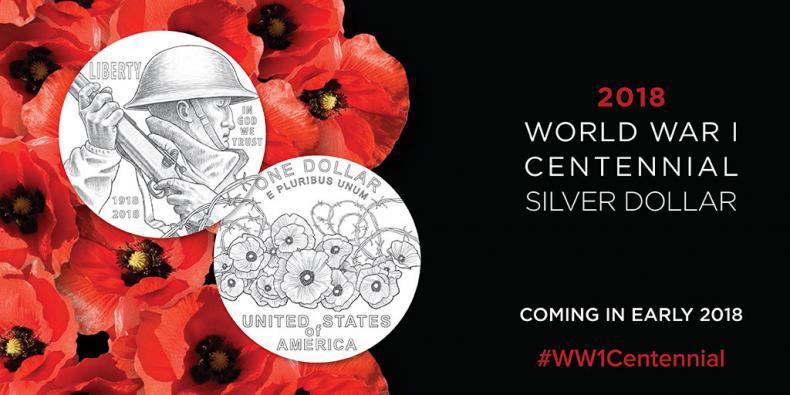
On Monday, the U.S. Mint unveiled its commemorative silver dollar marking the centennial of American involvement in World War I.
Acting Secretary of the Army Ryan McCarthy hosted the event at the Association of the U.S. Army’s Annual Meeting and Exposition in Washington, D.C. He was joined by T.V. Johnson, the Mint’s director of corporate communication, and Terry Hamby, chairman of the U.S. World War One Centennial Commission.
“This is a great day, because it is an opportunity for us to remember the 4.7 million American men and women who served 100 years ago as soldiers, as sailors, as Marines, as airmen and as Coast Guardsmen during World War I,” McCarthy said. “Their service, their inspiring legacy, is our nation’s heritage. It is our gift to future generations of Americans.”
The collectible coin will be available for purchase from the Mint in January. A portion of the proceeds will go toward construction of the new National World War I Memorial at Pershing Park, a block from the White House.
The coin’s artist is LeRoy Transfield of Orem, Utah, who will receive $10,000 as the winner of the Mint’s open design competition.
“On a personal level, as an artist, it’s fulfilling to have your work accepted for something as important as this,” Transfield said. “I did the best job I could, but it was my first attempt at a coin design, so I didn’t expect to win. It’s a wonderful thing to be part of.”
The obverse design of the coin is titled “Soldier’s Charge,” and depicts an American soldier gripping a rifle above strands of barbed wire. On the reverse side is “Poppies in the Wire,” which features abstract poppies among barbed wire. The wire represents trench warfare, while poppies are the symbolic flower of veteran remembrance, a tradition that began during the war.
A sculptor, Transfield has designed war memorials in four Utah cities: Orem, Salem, Santaquin and Springville.
“The Mint had a conference call where we could ask questions,” he said. “I asked, ‘What are some of the common mistakes a beginner makes when designing a coin?’ The most common error is putting in too much detail because the coin is going to be only an inch and a half wide. I realized I was going the wrong direction and cropped my design a lot.”
For the obverse, Transfield began with the image of a doughboy, then added a rifle, then barbed wire. The reverse side took more time.
“I started with an eagle, then tried a carrier pigeon, but it wasn’t working,” he said. “A day before I had to finish it, I came up with the poppies and barbed wire. When I saw it, I was really happy with it. It was a design I could be proud of and didn’t second-guess.”
Transfield is originally from New Zealand, where two of his relatives were veterans of the Great War: his great-uncle, Huriwhenua Taiaroa, and his grandmother’s cousin, Te Oti Taiaroa. They were Maori and served in New Zealand’s native contingent.
The coin was authorized by Congress in 2014, via bipartisan legislation sponsored by Reps. Emanuel Cleaver, D-Mo., and Doug Lamborn, R-Colo., in the House and Sens. Claire McCaskill, D-Mo., and Roy Blunt, R-Mo., in the Senate.
“This new coin will help us to remember the stories, and the lessons, from the people who served in that war,” Cleaver said. “It will help to preserve their legacy.”
This is the Mint’s first commemorative coin program memorializing the Great War; in the 1990s, coin programs supported the Korean War Veterans Memorial, the Vietnam Veterans Memorial, the 50th anniversary of World War II and preservation of Civil War battlefields.
“World War I was the war that changed the world,” Hamby said. “Millions of families across our country were impacted by this war, and we all continue to be touched by it every day. This coin is a tangible way for those families, and for all people, to be a part of this special centennial period.”
Surcharges of $10 per coin sold will be paid to the U.S. Foundation for the Commemoration of the World Wars, which supports the U.S. World War One Centennial Commission in commemorating the war’s centenary. The commission will use these funds to build a memorial in the nation’s capital.
The American Legion supports the U.S. World War One Centennial Commission by resolution. Jack Monahan of Connecticut is the Legion’s representative on the commission.
Read more about the World War I commemorative coin at www.worldwar1centennial.org/3208.
Read more about the National World War I Memorial at Pershing Park at www.worldwar1centennial.org/honor/national-wwi-memorial.html.
